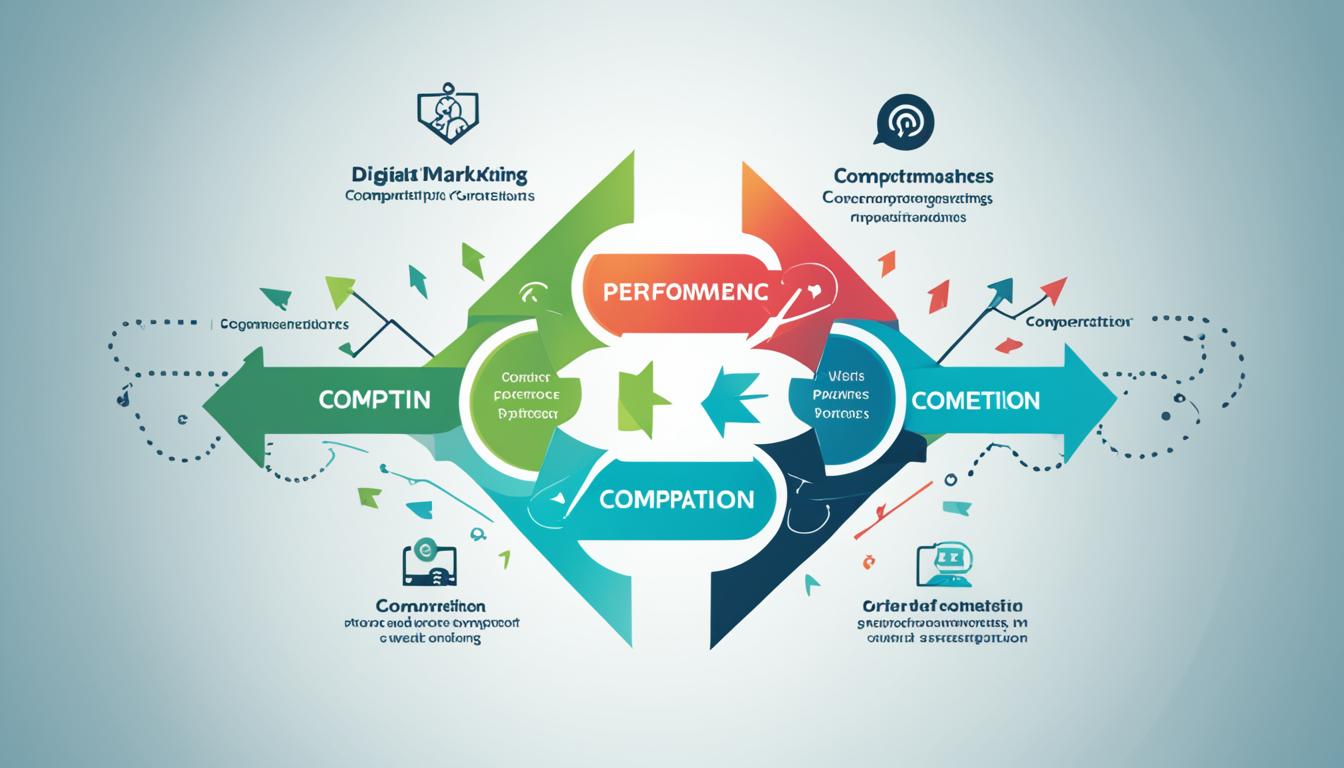In marketing, knowing and using important metrics is key to doing well. The Cost Per Install (CPI) is especially important for gauging ad campaign effectiveness.
CPI in marketing is the price advertisers pay an ad network for each app install. It shows how well advertising money is spent and what getting new customers costs. By figuring out the CPI, marketers can see if their investments are paying off.
Using CPI marketing strategies well helps companies use their ad budgets better and get new app users more cost-effectively. By keeping track of CPI, marketers can pinpoint what affects their campaigns and make needed improvements.
Key Takeaways:
- CPI in marketing measures the cost paid for each installation of a mobile app.
- It is an essential metric for evaluating the success of advertising budgets.
- Implementing effective CPI marketing strategies can optimize ad spend.
- Monitoring CPI helps identify factors impacting campaign performance.
- Analyzing CPI allows marketers to make informed decisions about their marketing strategies.
Understanding the Consumer Price Index (CPI)
The Consumer Price Index (CPI) helps us measure inflation and see price changes for consumers. It’s made from a survey with 80,000 price points from shops and services across the U.S. This survey looks at things like housing rents, user fees, and sales taxes. These all reflect what people spend their money on.
Different parts of the CPI carry different weights. For instance, housing rents make up about a third of the CPI. This shows it’s a big part of the calculation. The CPI also adjusts for any upgrades in product quality. This makes sure the index truly shows price changes for goods and services.
The Bureau of Labor Statistics (BLS) creates two key indexes from the CPI: CPI-U and CPI-W. CPI-U covers most of the U.S. population, 93% to be exact, and is the main inflation measure we hear about. CPI-W, however, looks at wage earners and clerical workers specifically.
Understanding the CPI report is vital for many people. It helps policymakers, businesses, and everyday consumers understand inflation better. This helps them make better decisions on economic policies, investments, and their budgets. Keeping an eye on the CPI report lets everyone better grasp how price changes affect the economy and their choices.
In short, the CPI is vital for tracking inflation and seeing how consumer prices trend. It’s built on a detailed price survey and adjusts for product quality changes. The CPI report is packed with insights on inflation. It’s used as a guide for policy decisions and economic evaluations.
Types of CPIs
The Consumer Price Index (CPI) tracks the monthly price changes paid by U.S. consumers. The Bureau of Labor Statistics (BLS) shares two CPI indexes each month. Each index has a unique purpose and coverage.
The CPI-U is for 93% of the U.S. population and provides a broad look at price changes. It includes many types of consumers, covering a wide range of goods and services.
The CPI-W focuses on wage earners and clerical workers. It helps adjust federal benefits to match the cost of living. This ensures these workers’ incomes stay in line with living expenses.
Both CPI-U and CPI-W offer insights into how price changes affect different people. They use different methods and samples to calculate these changes.
CPI-U Coverage
The CPI-U captures the spending habits of urban households. It represents most of the U.S. population. This index includes expenses like food, housing, and healthcare.
By tracking price changes in these areas, the CPI-U helps us understand inflation and deflation.
CPI-W Coverage
The CPI-W specifically targets wage earners and clerical workers. It looks at the spending patterns of these job groups. This index tracks price changes in goods and services important to these workers.
This ensures that income adjustments reflect their real economic situations. It makes sure they can keep up with living costs.
Although they focus on different groups, both indexes are crucial. They help measure price changes and guide economic choices. Knowing the differences between the CPI-U and CPI-W helps make better decisions based on accurate inflation data.
CPI Formulas
The Consumer Price Index (CPI) is key for understanding inflation. It tracks how consumer prices change over time. Two main formulas are used: the annual CPI and the inflation rate.
Annual CPI Formula
The annual CPI looks at price changes for certain goods and services year over year. To calculate it, divide the current year’s basket value by last year’s. Then, multiply by 100.
Annual CPI = (Value of Specific Basket in Current Year / Value of Specific Basket in Prior Year) * 100
Inflation Rate Formula
The inflation rate shows how quickly prices are changing. First, subtract the old CPI from the new one. Next, divide by the old CPI. Finally, multiply by 100 for the result.
Inflation Rate = ((New CPI – Prior CPI) / Prior CPI) * 100
These methods help experts and businesses understand price changes. Calculating the CPI and inflation rate reveals trends. This aids in making smart decisions.
Example Calculation
Imagine the current year’s goods basket is worth $500, but it was $450 last year.
Annual CPI = ($500 / $450) * 100 = 111.11
Suppose the old CPI was 100, and the new one is 111.11. We can find the inflation rate like this:
Inflation Rate = ((111.11 – 100) / 100) * 100 = 11.11%
Understanding CPI and inflation rate formulas is powerful. They give insights into inflation. This information helps businesses and policymakers with key decisions.
| Formula | Description |
|---|---|
| Annual CPI | Calculates the change in prices of a specific basket of goods from one year to the next. |
| Inflation Rate | Measures the rate of change in consumer prices over time. |
How Is the CPI Used?
The Consumer Price Index (CPI) is key in many areas of the economy. It influences economic policy, business choices, and pay talks.
Economic Policy
Financial experts keep a close eye on CPI data. It helps shape economic policies. The Federal Reserve, for instance, uses this data to set the Fed funds rate. Changing this rate affects loans and economic growth.
When the Fed adjusts rates, it aims to keep the economy stable and growing. This is because rate changes affect borrowing costs.
Business Decisions
Companies use the CPI to make smart choices. It shows price trends, which helps businesses set their prices right. They watch the CPI to guess what consumers will do next.
This helps them plan their stocks and think about new markets. Knowing about price changes helps them stay competitive.
Pay Negotiations
The CPI is important for deciding pay raises too. It shows how consumer prices change, affecting what people can buy. During wage talks, the CPI guides discussions on salary increases and living costs.
Workers and unions use it to argue for wages that match inflation. This helps them keep their buying power.
In short, the CPI matters a lot to economic policies, business planning, and pay discussions. It gives crucial details on pricing, affecting many economy parts.
CPI Definition in Marketing
In marketing, CPI means Cost Per Install. It’s the cost an advertiser pays an ad network for each new user who installs a mobile app. It helps marketers measure how well their ad spending is working.
To figure out CPI, divide the ad spend by the number of app installs from that campaign. It shows if the budget for ads and getting new customers is successful.
Marketers track CPI to see if their ads are effective at bringing in new app users. This is crucial in mobile app marketing, where it’s hard to stand out. By knowing their CPI, they can spend smarter and get better returns.
To calculate CPI, use this formula:
CPI Calculation Formula:
CPI = Ad Spend / Number of Installs
This formula helps marketers see the average cost for each app install. It’s a key way to check if marketing is working without wasting money.
By keeping an eye on CPI, marketers learn if their ad money is used well. They can see which methods bring in users best and which ones need work. Watching CPI also sets realistic goals for how much getting a new customer should cost.
| Advantages of CPI in Mobile App Marketing | Disadvantages of CPI in Mobile App Marketing |
|---|---|
|
|
Using CPI helps advertisers understand their marketing better. It lets them know if they’re spending their money wisely. Plus, it guides them in making their user getting strategy better.
CPI vs. Other Cost Models
In the world of mobile app marketing, CPI truly stands out. It’s different from CPM, CPA, and eCPI. Knowing what sets these cost models apart is key for marketers. This knowledge helps to fine-tune advertising strategies. Let’s explore how CPI is unique compared to others:
CPI vs. CPM: Capturing Installations vs. Views
CPI and CPM measure different things. CPM looks at ad views, but CPI tracks app installs. With CPI, you pay for each install, making sure money goes towards gaining new users. This approach lets marketers see the real effect of their efforts in user growth.
CPI vs. CPA: Cost Per Install vs. Post-Install Actions
CPI focuses on the cost of each app install. In contrast, CPA deals with actions taken after installing, like purchases or sign-ups. While both give useful insights, CPI zeroes in on growing the user base from the start.
CPI vs. eCPI: Factoring in Organic Variances
eCPI accounts for both paid and organic installs. It calculates the cost per install by including all user acquisitions. This means, besides direct campaign results, eCPI considers long-term growth from organic installs.
These cost models—CPI, CPM, CPA, and eCPI—each play a role in understanding app marketing. They help track different stages of user interaction, from seeing an ad to engaging with the app. Marketers use these insights to reach their goals.
| Cost Model | Focused Metric | Main Purpose |
|---|---|---|
| CPI | Cost Per Install | Measuring app installations and user acquisition |
| CPM | Cost Per Mille (Impressions/Views) | Evaluating ad impressions and reach |
| CPA | Cost Per Action (Post-Install Metrics) | Tracking specific user actions after installation |
| eCPI | Effective Cost Per Install | Considering organic installations along with paid installs |
How to Reduce CPI
To improve your marketing and lower CPI (Cost Per Install), you need to look at several things. These include which ad networks you use and the type of app you have. Also important are which devices your audience uses, where they are in the world, and the style of your ads.
Factors Impacting CPI Costs
For effective CPI campaigns, consider these key points:
- Ad Networks: Choose an ad network that fits your audience and goals. Each one offers different rates and effectiveness.
- App Verticals: The category your app falls into affects CPI. Competitive areas might cost more, but niche markets could be cheaper.
- Device Platforms: Costs can vary between devices like iOS or Android. Know your audience’s preferences to use your budget wisely.
- Target Markets: Location matters. Costs change based on competition and pricing in different regions. Look for the most affordable options.
- Ad Types: Trying various ad styles and positions can affect costs. See which ones give you the best value for money.
Thinking over these factors helps marketers find ways to lower CPI and boost campaign outcomes.
Reducing CPI Costs
To cut down on CPI, check how you stack up against the average. Knowing the normal CPI for your region and app type is useful. It shows where you can get better.
Get industry benchmarks from reliable sources. They point out if your CPI is unusually high and suggest how to adjust. This helps fine-tune your approach.
Also, keep an eye on your CPI data and its effects on your budget. Regularly check how your campaigns are doing. This lets you make informed choices to spend smarter and lower your CPI.
Lowering CPI requires ongoing effort. Stay sharp, look at important factors, and adjust based on solid data. This way, you can make your CPI efforts more effective and get a better marketing ROI.
| Factors Impacting CPI | Potential Impact |
|---|---|
| Ad Networks | Different pricing structures and reach |
| App Verticals | Industry competitiveness |
| Device Platforms | iOS, Android, etc. |
| Target Markets | Geographic variations in competition and pricing |
| Ad Types | Format and placement of ads |
This table helps marketers see how each factor influences CPI. With it, you can focus your efforts on what will really make a difference in costs.
Importance of CPI in Marketing
In marketing, keeping an eye on CPI is key. It helps ensure campaigns stick to their budget while being effective. CPI lets marketers know how well their ads do in getting new app users. But CPI isn’t the only thing to watch. Looking at average revenue per user, how engaged users are, and how long they stay is also crucial. This gives a full picture of a campaign’s success.
Monitoring CPI in the Marketing Budget
Adding CPI to the marketing budget helps in planning and spending wisely. By watching CPI trends, marketers can spot and fix costly areas. For instance, if a marketing channel costs a lot but doesn’t bring many users, it’s smart to spend that money elsewhere. This can make the marketing budget work better and boost ROI.
Calculating CPI ROI
To understand if campaigns are profitable, calculating CPI ROI is necessary. This involves comparing the revenue from new users to the cost of getting them. By doing this for various campaigns, marketers can see which ones are worth the investment.
But remember, CPI isn’t everything. Other metrics like customer lifetime value and how often customers come back are important too. They help understand the long-term effects of marketing efforts.
| Benefits of monitoring CPI in the marketing budget: |
|---|
| 1. Optimize resource allocation and budget planning |
| 2. Identify areas of inefficiency and reallocate funds |
| 3. Improve overall marketing budget performance |
Conclusion
The Consumer Price Index (CPI) is very important for marketing. It’s especially key in mobile app marketing. It tells marketers how much each install costs. This helps them see if they are spending their ad budget wisely.
To get the most from CPI campaigns, it’s smart to compare them to what others are doing. Knowing how you stand compared to others can show where you might get better. By using this kind of info, you can make your campaign more effective. This leads to a better return on your investment.
But remember, CPI isn’t everything. You should also look at how much money each user brings in and how engaged they are. Things like how long people use your app matter too. Looking at all these things together helps you understand if your campaign works well.
In short, CPI is really useful for seeing if your marketing is working. It helps you know how well your app is doing in getting new users. By being smart about CPI and learning from what others do, you can make your app marketing a lot stronger. This will help you get more from the money you spend on ads.




